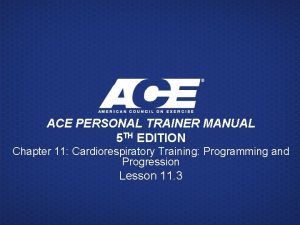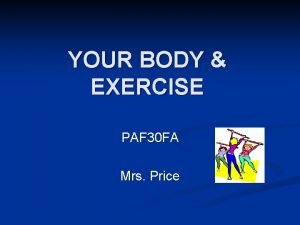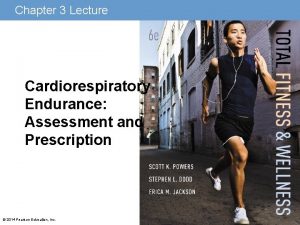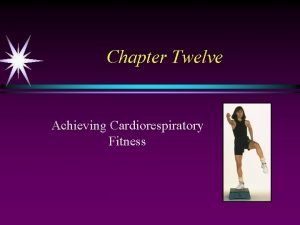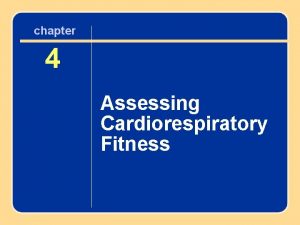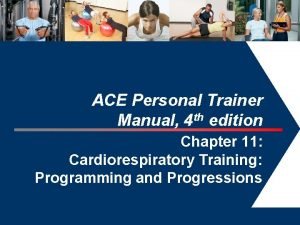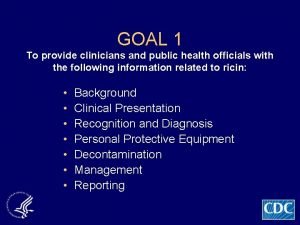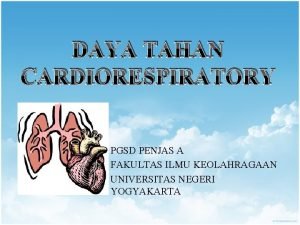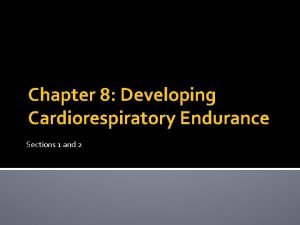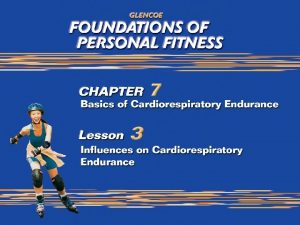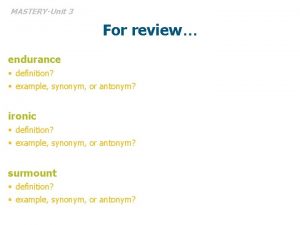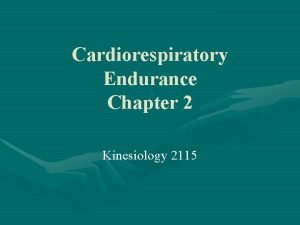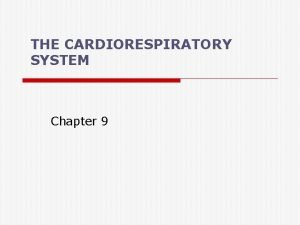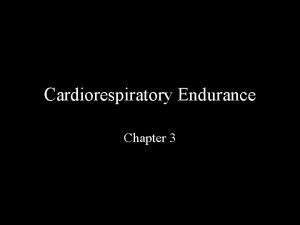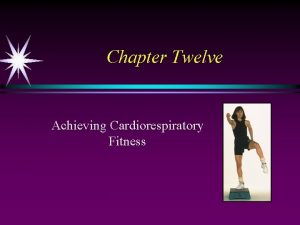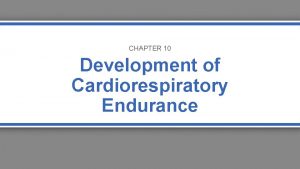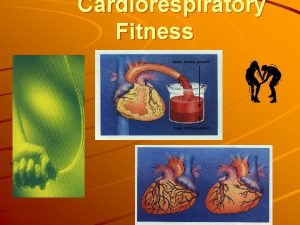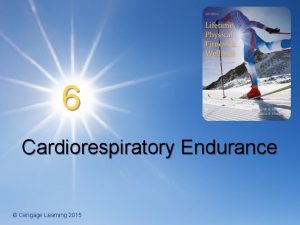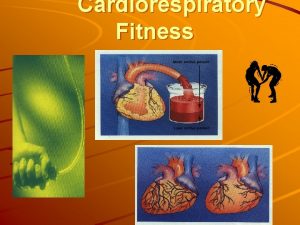Chapter 11 Power Point Cardiorespiratory Training Program Design













- Slides: 13

Chapter 11 Power Point Cardiorespiratory Training: Program Design

Muscular System • Adaptations to Cardiorespiratory Exercise • Muscular system • Increase in • Number of Type 1 Muscle Fibers (slow twitch) increase in Size and # of mitochondria* • Capillaries around recruited muscle fibers • Enhances delivery of oxygenated blood • Slow twitch fibers for low-intensity cardio • Fast-twitch fibers for high-intensity • Increase in the number of anaerobic enzymes to enhance anaerobic energy production

Cardiovascular system • Adaptations to Cardiorespiratory Exercise • Heart muscle hypertrophy and enlarging of the heart chambers leads to a larger stroke volume* (volume of blood pumped per beat) • Leads to a higher cardiac output • Higher cardiac output leads to a lower resting heart rate* • 50 bpm x 100 m. L per beat = 5000 m. L cardiac output • 80 bpm x 62. 5 m. L per beat = 5000 m. L cardiac output

Respiratory System • Adaptations to Cardiorespiratory Exercise • Increased ventilation of the alveoli • Increased tidal volume – leads to better oxygen delivery • Respiratory Muscles • inspiration • pull rib cage upward – sternocleidomastoid, scalene, serratus anterior • expiration • pull rib cage downward – rectus abdominis and quadratus lumborum

Respiratory System • Time required to increase aerobic capacity • VO 2 max plateau’s within 6 months • Ventilatory threshold (VT) can grow for years • Physiological adaptations to steady-state and interval-based exercise • 3 -4 minutes to reach steady state • Steady state running program includes the adaptation of increased red blood cell count* • Rate of O 2 uptake (VO 2), HR, CO, ventilation, blood lactate concentration, and body temperature reach stable levels (elevated) after a short period of exercise • Interval training yields similar or even greater results • Increases tolerance for buildup of lactate (lactate threshold)

Components of a Cardio Workout • Components of a cardiorespiratory workout • Warm-up • 5 -10 minutes • Harder conditioning phase or older exerciser needs more extensive warm-up • Conditioning phase • Cardiovascular drift: gradual increase in HR response during steady-state bout of exercise • Higher intensity intervals recruit higher levels of type II muscle fibers and are considered aerobic overall • Cool-down • 5 -10 minutes • Gradual reduction toward low intensity

Guidelines for Health, Fitness, and Fat Loss • FITTE • Frequency – number of workouts per week • Intensity – difficulty of exercise • Time – length of the workout • Type – what exercise is being performed • Enjoyable – level of enjoyment • Frequency (in healthy adults) • Moderate intensity = at least 5 days per week • Vigorous intensity = at least 3 days per week • Combination of both = 3 -5 days per week

Guidelines for Health, Fitness and Fat Loss • Intensity – Many ways to measure intensity, choose easiest Maximal Heart Rate – (220 -age) Use percentage of Max HR (65% - 90% Max HR) RPE Scale – 6 -20 Borg Scale or 0 -10 Category Ratio Scale VO 2 Max % Caloric Expenditure Talk Test – use for all special populations and beginners Blood Lactate & VT 2 – use meter similar to blood glucose meter to measure blood lactate (not recommended) • Three Zone Training Model • • Zone 1 = HR below VT 1 • Zone 2 = HR between VT 1 & VT 2 • Zone 3 = HR Above VT 2 • Karvonen method for finding HR/training percentage (higher resting HR associated with lower training HR) • Target HR (THR) = (HRR x %intensity)+RHR • HRR=MHR-RHR

Guidelines for Health, Fitness and Fat Loss • Time/Exercise Duration • Total time spent performing the cardiorespiratory activity • Performed continuously or throughout the day • USDHHS and Surgeon General recommend 30 minutes a day 5 days a week or 150 total minutes* • Exercise progression • Principle of Overload – progress based on the clients conditioning level • Principle of Specificity – utilize specific needs and timelines of the client to progress training • Fartlek training: sequence of different intensities that stress both the aerobic and anaerobic systems – directly training in the intensities of the a sport or game

Modes/Types of Cardio Exercise • Equipment-based exercise • Group exercise • Circuit training • Seasonal exercise • Water-based exercise • Mind-body exercise • Lifestyle exercise • Outdoor exercise • Always check for potential dangers before setting up an outdoor exercise class*

Modes/Types of Cardio Exercise • Outdoor Exercise • In the heat • Peripheral vasodilation: blood brought to surface of skin to reduce internal heat load • Heat exhaustion - Hot humid environment is the most dangerous* • Heat stroke - Hot humid environment is the most dangerous • In the cold • Hypothermia • Frostbite • Higher altitudes • O 2 in air reduced due to partial pressure

ACE-IFT Cardio Training Phases • Phase 1: Aerobic-base training • • Create positive experience Focus on steady-state Gauge by talk-test Progress client when they can sustain steady-state cardio for 20 -30 minutes in zone 1/RPE 3 -4 • Phase 2: Aerobic-efficiency training • Increase duration and introduce intervals • Increase workload at VT 1 and introduce low VT 2 (RPE 5)

ACE-IFT Cardio Training Phases • Phase 3: Anaerobic-endurance training • • For those with endurance or performance goals Use VT 2 threshold test to determine HR at VT 2 Increase focus Overtraining Syndrome can occur if not enough recovery days are taken* • Phase 4: Anaerobic-power training • • Increase anaerobic power Improve phosphagen energy pathways Buffer large accumulations of blood Most clients generally wont work in this phase • Special considerations • Youth – emphasize development of motor skills • Older adults – lower intensities with slower rates of progression
 Ace ift model cardiorespiratory training
Ace ift model cardiorespiratory training Paf 30
Paf 30 Benefits of cardiorespiratory training
Benefits of cardiorespiratory training Achieving cardiorespiratory fitness can
Achieving cardiorespiratory fitness can Agranulocytes
Agranulocytes Assessing cardiorespiratory fitness
Assessing cardiorespiratory fitness Ace ift model cardiorespiratory
Ace ift model cardiorespiratory Cardiorespiratory failure
Cardiorespiratory failure Cardiorespiratory adalah
Cardiorespiratory adalah Developing cardiorespiratory fitness
Developing cardiorespiratory fitness Describe cardiorespiratory endurance
Describe cardiorespiratory endurance Crystal ball fortune teller
Crystal ball fortune teller Active power reactive power apparent power
Active power reactive power apparent power Power bi training powerpoint
Power bi training powerpoint
